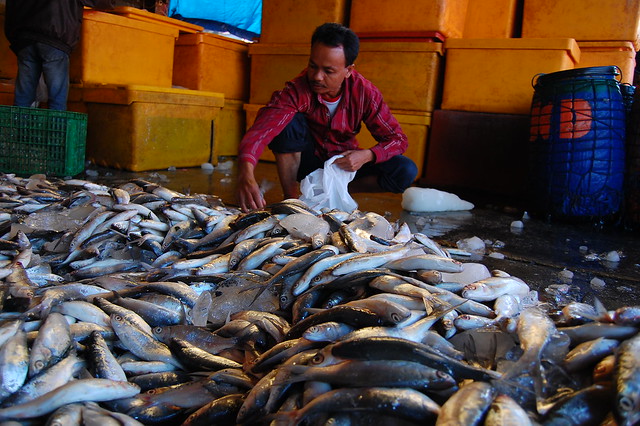人為垃圾在海洋形成化學濃湯,跨國研究團隊最近發現,加州和印尼部分市場賣的食用魚,每四條魚中就有一條內臟中有塑膠垃圾,或是來自洗衣廢水的人造纖維。
印尼一名魚販正在挑揀漁貨。圖片來源:Ikhlasul Amal(CC BY-NC 2.0)
漁獲發現塑膠 印尼55% 加州67%
來自加州大學戴維斯分校和印尼哈桑丁大學的研究人員,從印尼望加錫的市場採集76份魚樣本,以及從加州半月灣和普林斯頓的市場蒐集64份魚樣本進行分析。研究結果發表於「科學報告」期刊,是首個探討塑膠垃圾和餐桌上食用魚關連性的研究。
研究人員向魚市場或漁夫蒐集全魚、魚的消化道和整隻的雙殼綱樣本。樣本物種包括吳郭魚、鰹魚、鮭魚、鯡魚、鯖魚、鰺和鯛魚。
不是每個樣本內臟內都有塑膠。內臟驗出塑膠垃圾或纖維的有印度鯖魚、長身圓鰺、日本銀帶鯡、兩個品種的臭都魚和未能歸類的鰺科魚。
在印尼,28%的魚和55%的所有物種驗出塑膠製品垃圾。在美國情況也相似,25%的魚和67%的所有物種驗出塑膠製品垃圾。貝類樣本中有33%驗出塑膠垃圾。
垃圾不太一樣 印尼塑膠多
印尼樣本中發現的垃圾都是塑膠。加州樣本中發現的垃圾有80%是纖維,但印尼樣本中完全沒有纖維。
「奇怪的是,各地的魚內臟中發現的垃圾量差異不大,但塑膠和纖維的類別差異卻很明顯。我們認為原因在於當地垃圾管理上的差異。」主要作者、加州大學戴維斯分校獸醫系水產健康計畫博士後研究員Chelsea Rochman說。
印尼的掩埋場和垃圾蒐集回收場不多。大量塑膠垃圾被丟在海邊進入海洋。因缺少淨化飲用水,印尼居民必須喝瓶裝水,也常常丟棄塑膠瓶。
「印尼的海洋生態豐富性和多樣性數一數二,其海岸地區,包括紅樹林、珊瑚礁和海灘,卻充滿垃圾。」共同作者、在印尼進行研究多年的戴維斯分校博德加海洋實驗室教授Susan Williams說。
加州回收先進 洗衣廢水仍露餡
美國有先進的塑膠蒐集和回收系統。但大部分加州居民用洗衣機洗衣服,廢水排入加州沿岸的200座處理場。
作者認為,加州魚樣本中的纖維來自這些洗衣廢水。「從當地垃圾管理策略著手應有助於解決這個問題。」Rochman說。
科學家強調,塑膠和纖維是從魚的內臟中驗出,因此只有在吃下全魚時才會吃下這些垃圾。像印尼有吃全魚的習慣,或是食用如沙丁魚、鳳尾魚,以及蛤和貽貝等貝類。如果人把含有這些垃圾的魚吃下肚,作者表示可能有「物理性損傷導致細胞壞死、胃腸道炎症和組織撕裂傷的風險。」
研究者警告,人工垃圾在海洋環境中形成綜合化學濃湯,包括來自廢水排放和垃圾本身成份的化學物質。部分化學物質透過攝食垃圾進入魚體內,如果塑膠破壞或摧毀魚群,可能衝擊人類的糧食安全。
Roughly one in every four fish sold for human consumption in certain California and Indonesian markets contain plastic fragments or textile fibers in their guts, an international team of scientists has found.
Published in the journal “Scientific Reports,” the study is one of the first to directly link plastic debris with the fish that shows up on dinner tables.
Researchers from the University of California, Davis, and Hasanuddin University in Indonesia sampled 76 fish from markets in Makassar, Indonesia, and 64 from Half Moon Bay and Princeton in California.
The researchers collected whole fish, GI tracts of fish and whole bivalves directly from fish markets or from fisherman selling their catch for human consumption.
Not all fish tested had plastic in their guts. Species tested included tilapia, skipjack tuna, salmon, herring, mackerel, scad and snapper. Plastic debris or fiber was found in the guts of Indian mackerel, shortfin scad, silver-stripe round herring, two species of rabbitfish, and fish from the family Carangidae that could not be identified as to genera.
In Indonesia, manufactured debris was found in 28 percent of individual fish and in 55 percent of all species. Similarly, in the United States, anthropogenic debris was found in 25 percent of individual fish and in 67 percent of all species.
Manufactured debris was also found in 33 percent of individual shellfish sampled.
All of the fragments recovered from fish in Indonesia were plastic. In contrast, 80 percent of the debris found in California fish was fibers, but not a single strand of fiber was found in the Indonesian fish tested.
“It’s interesting that there isn’t a big difference in the amount of debris in the fish from each location, but in the type – plastic or fiber,” said lead author Chelsea Rochman, a postdoctoral fellow in the Aquatic Health Program at the UC Davis School of Veterinary Medicine.
“We think the type of debris in the fish is driven by differences in local waste management,” said Rochman.
Indonesia has few landfills and little waste collection or recycling. Instead, large amounts of plastic are tossed directly onto the beaches and into the ocean.
A lack of purified drinking water that forces Indonesian residents to drink bottled water, and they often toss the plastic bottles.
“Indonesia has some of the highest marine life richness and biodiversity on Earth, and its coastal regions – mangroves, coral reefs and their beaches – are just awash in debris,,” said co-author Susan Williams, a professor with the UC Davis Bodega Marine Laboratory who has worked on projects in Indonesia for years.
Meanwhile, the United States has advanced systems for collecting and recycling plastics. But most Californians wash their clothes in washing machines, the water from which empties into more than 200 wastewater treatment plants off the California coast.
The authors theorize that fibers remaining in sewage effluent from washing machines were ingested by the fish they sampled in the state.
“To mitigate the issue in each location, it helps to think about local sources and differences in waste management strategies,” Rochman said.
The scientists emphasize that the plastic and fibers are found in the fishes’ guts so humans are likely to eat the debris only if the fish is eaten whole, as it is in Indonesia, or as with sardines and anchovies or shellfish such as clams or mussels.
But if people do eat the plastic debris along with their fish, the authors say they risk “physical damage leading to cellular necrosis, inflammation and lacerations of tissues in the gastrointestinal (GI) tract.”
“Moreover, in nature,” the authors write, “anthropogenic debris is recovered from the marine environment with a cocktail of chemicals, including chemicals accumulated from ambient water, in addition to the ingredients of the debris itself. Some of these chemicals can transfer from the debris to fish upon ingestion.”
Human food security could be impacted if the plastics damage or destroy whole populations of fish, they warn.
※ 全文及圖片詳見:ENS








